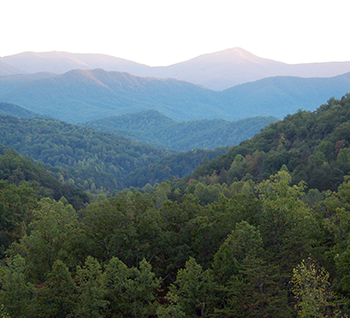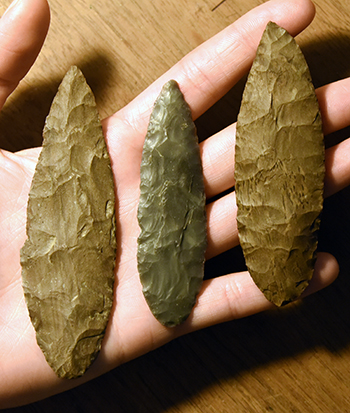
|
The most frequently visited US National Park and a UNESCO world heritage site, the Smoky Mountains harbor a wealth of biodiversity.

Visit a large Native American Settlement at The Old Stone Fort near Manchester. Below: Cache of stone blades, Hiawassii Isle, TN.

|
|
About 2.6 million years ago, the Quaternary was announced by ice sheets.
The grinding mill of evolution was a two mile glacier creeping as far south as Missouri, crushing everything in its path, pulsing and retreating over thousands of years in synchrony with the Earth's wobbling spin.
Funneled between the Rocky and Appalachian mountains, intense seasons entrained rich ecosystems of deciduous forest that still dominate Tennessee's landscapes today, creating one of the most biodiverse places on Earth. Beyond the reach of glacial ice, Tennessee rivers wound through living communities that remained pristine for tens of millions of years, filled with unique fish and dozens of species of freshwater clams.
Far away, early humans were spreading and diversifying. In the last 100,000 years of the Quaternary, primates ranged from Gigantopithicus -- 1200 pounds of 10 foot orangutan -- to tiny Homo floresiensis -- a tool-using hominid only 3.5 feet tall. Only within the most recent 15,000 years, traveling over the ice-stranded tundra of Beringia, did a few modern humans find their way from Siberia into North America.
The first Tennesseeans faced mammoth, giant sloth, massive cave bear, and saber-toothed tiger. Using stone tools they built a trading empire tens of millions strong that would sprawl across continents. But in the final centuries they would loose their land and cultures to Europeans with superior technologies. In the Battle of Horseshoe Bend, Tennessee Indian hunter and future U.S. President Andrew Jackson cut off the noses of 900 dead "indians" to document his victory. Eventually, Native Americans would be almost erased from the rolls of history, their languages, heroes and achievements forgotten except for chipped stone tools that you can find today in Tennessee stream beds.
But as we stand on the threshold of past and future, what will become of us?

|